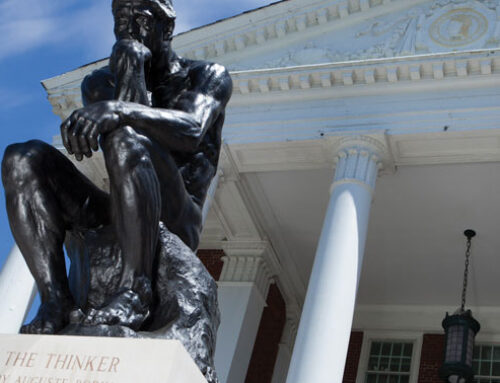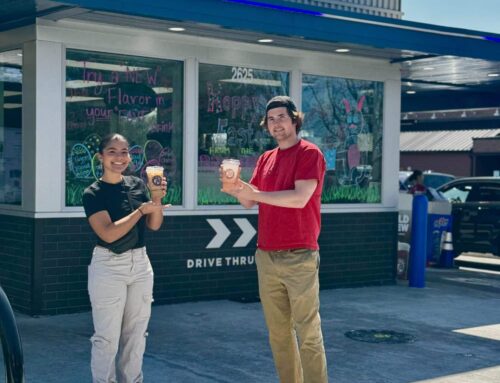By Simon Isham and Anna Meany–
The Old House
The Old House is a three-story Federal style townhouse that stands at 436 S. Fifth St. in downtown Louisville. Built in 1829, the Old House holds the predictable title of oldest residence in the city.
One of the earliest buyers was Dr. William A. McDowell, a man best-known for his research into tuberculosis, with the Old House serving as both his primary residence and as his surgery. One of McDowell’s preferred treatment methods was to send his patients to Mammoth Cave to benefit from the cool, damp air. As science later proved, these conditions are not conducive to recovery, and many of McDowell’s patients would return to him with worsening symptoms. These patients would suffer through their final days living with McDowell, confined to the Old House.
After McDowell died of a heart attack, J.F. Canine acquired the house in 1868. Canine was, aptly, a dentist by trade. In order to provide his patients with the most up-to-date medical care, Canine took the liberty of installing electricity, light bulbs, steam heating, and a steam-powered dental drill. The only local anesthetic known to science in the antebellum era was cocaine, and yet W. Leigh Burton, a prominent dentist of the period, stated that he might pull 20 teeth and fill 30 cavities in a single day.
During the Progressive Era, the shallow basement of the Old House was converted into a tenement, a type of substandard multi-family dwelling in the urban core. It was neglected by the owner and sank quickly into disrepair—literally. The outside wall which forms the alley must now be supported by a steel framework to avoid collapse as a result. Largely due to the state of the Old House at the time, atlases of the era classified the neighborhood as a slum.
In 1946, the House’s tragic past was forgotten, and it was converted into a ritzy restaurant where the likes of Walt Disney, Raymond Burr, Rocky Marciano and Ronald Reagan dined. It has recently become the offices of Precision Printing. Every so often, though, people will swear they saw a curtain close on its own, saw a man appear out of thin air in the third floor corridor, or will hear phantom footsteps in the alley or throughout the house. Are they the ghosts of tenement dwellers, TB sufferers, or dental patients hoping to escape the drill? Who knows?
 Louisville Palace Theater
Louisville Palace Theater
Opened 1928 as Loew’s Theater, the Louisville Palace made its name by providing its patrons with the most popular movies in a beautiful setting. The theatre is one of the largest of its kind, seating 2,700, and has a very unusual exterior which combines Spanish Baroque architecture with art deco motifs. Its gorgeous and embellished ornamentation hides a haunted secret, however.
The Louisville Ghost Hunters Society reported that employees have repeatedly seen a maintenance man roaming about the Palace, whistling, doors opening on their own, and numerous technical malfunctions plague the Palace. Investigations proved that, in 1965, an employee named Ferdinand Frisch died of a heart attack in the basement, where the same name has been seen mysteriously written in dust.
The Louisville Palace Theatre is located at 625 S. 4th St. downtown. It still regularly plays movies and schedules concerts.

A photo of the Old University of Louisville Medical school in 1944, when the building was still used for classes.
The Old University Medical School
The building that is now the Old University of Louisville Medical School was initially constructed in 1891 as a rival to the already established University of Louisville Medical School. It opened its doors in 1893, and in 1908, it was absorbed into the U of L Medical School. The school has a tradition of innovation in medicine. For example, in 1911, the facility launched the nation’s first trauma care center, in 1970, the Pap Smear was invented, and in 1999, the first successful hand transplant was performed. But the school has a tradition of spooky happenings as well.
The medical school is home to the Wolf Gallery, a location where the art of physicians and their families is displayed. On the tile floor at the end of the gallery is a permanent stain. This stain developed when the rooms of the Wolf Gallery were still anatomy classrooms. Students would often leave the rooms carrying trays of heads or limbs which were soaking in blood or formaldehyde. Sometimes the students would let their guards down, and the solution would slosh onto the floor. After years of this treatment, the stain formed, and cannot be removed, no matter what the janitorial staff tries.
In the basement of the building is the old embalming room, which was not a popular hangout for medical students. In it was a vat in which cadavers would soak in formaldehyde in the fetal position. When a body was required, it would be removed from the vat and hung on a hook to drain into a trough. This trough led directly into the city sewer. In 1996, the basement was renovated. While redoing the ceiling of one room, workers were surprised when a body part fell out of the ceiling. The school’s coroner ruled that the part had simply been misplaced.
In the late 1930s, one student at the school failed an exam which caused him to be expelled from medical school. Distraught, the student hung himself in the school’s four-story stairwell. Some time later, his professor noticed that he had made a grading error on the mathematics portion of the test, and that the student had actually passed. The professor was so upset that he committed suicide in the same way that his student had.
Workers in the building have complained that late at night, they hear alarms go off for no apparent reason, mysterious footsteps down the corridors, doors opening and closing, and the squeaking of gurney wheels at times when no one else is in the building. The Old Medical School is located on 101 W. Chestnut St.
The Brown Hotel and Theater

The exterior of the Brown Theater, which is adjoined to the Brown Hotel, in a 1925 photo.
The luxurious and historic Brown Hotel was built in 1923 in the colonial revival style. The hotel is the birthplace of the Hot Brown sandwich, and has been the hotel of choice for famous Derby-goers such as Harry Truman, Elizabeth Taylor, and Joan Crawford. It has even housed royalty; Queen Elizabeth II of England and Queen Marie of Romania both stayed there, briefly. But the living are not the only guests at the Brown.
It is sometimes said to still be the home of its original owner, James Graham Brown, who died of heart failure in 1969. The building is smoke-free, but visitors often report smelling the faint aroma of cigar smoke at the top of the staircase. Others report seeing the apparition of a man circulating about this area, with a cigar in hand. It is said that Brown’s ghost is most likely to appear when the 293-room hotel is filled with guests for special events, such as for the Kentucky Derby and for weddings. Keep a lookout for Mr. Brown, who enjoys overseeing his hotel lobby in 1920s garb and assisting employees by pressing elevator buttons late into the night.
In the adjoined Brown Theatre, reports of paranormal activity are no less strange. Actors often pass through unexplained cold spots while performing, and ghostly figures have even been spotted on stage at times when the theatre is not in use. Could these be the spirits of Louisville actors of long ago, come to share their techniques and critiques with a yougner generation?
Eastern Cemetery
Eastern Cemetery began its days in 1843 as the parish graveyard for the Fourth Street Methodist Episcopal Church. Five years later, the church decided to incorporate the site, modeling their land after Mt. Auburn Cemetery in Boston, the first cemetery to operate on the promise of a “park-like setting”.
The cemetery originally covered 15 acres, on which there were around 11,000 plots. In 1858, the corporation began to resell various plots, removing the headstones and marking the plots on their records as “old graves”.
In 1989, the problem became obvious. Rumors spread that coffins were buried so unsoundly that their corners stuck out of the ground. The owners of the graveyard were hauled off to prison, and an investigation was launched as to the extent of the problem. Experts estimated that an average of 7.2 burials per plot took place per plot. Remains and cremated remains are now under the charge of U of L archaeologist Phil DiBlasi, who specializes in the care and preservation of corpses.
With upwards of 80,000 dead crammed into one cemetery, it is no wonder that rumors of hauntings abound. Visitors to the cemetery have reported seeing mysterious figures appear in the chapel, and a ghostly woman who tends to the graves of infants.
Visitors are urged to take caution; the old chapel and crematorium—Louisville’s first—have fallen into severe disrepair as well, and homeless people often take up residence in the basement. Many of these homeless are intoxicated or mentally ill, so poking around is not advised.
Eastern Cemetery is located along Baxter Avenue, just blocks from the expensive Cave Hill Cemetery, where figures such as Colonel Sanders, George Rogers Clark and members of Kentucky’s prominent Speed family are buried.
The Bellamy Garage
The Bellamy Garage began its life as the Louisville manufacturing headquarters for American Standard, a bathroom and kitchen fixtures company. As the factory was built in the early 1900s in the beaux-arts style, the developers of the Bellamy ran into a lot of opposition from the Louisville community when they announced their plans to level the four story structure to make way for a parking lot. Now that the factory has been repurposed, it parks far more cars than a simple parking lot could have. Still, the century of history surrounding the building has led many to wonder if gutting the building really purged it of any spirits who may have dwelt there.
Despite any evidence of paranormal activity or investigations of ghostly encounters at the Bellamy Garage, Bellamy visitors and residents alike are unable to deny its inherent creepiness. How could an old brick factory stained by years of pollution escape this list? Although the garage is lit most of the time, there is always a chance that students will be forced to wander to their cars in total darkness.









